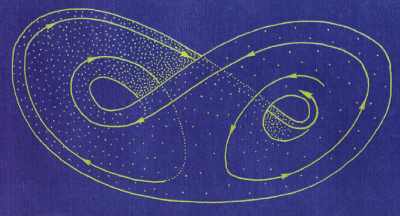Keep 'er steady
 A dynamical system is described by the equation
where
is an
order polynomial with roots
. In other words, the roots of
are the steady states of the system (
).
A dynamical system is described by the equation
where
is an
order polynomial with roots
. In other words, the roots of
are the steady states of the system (
).
Suppose the system is placed into one of the steady states and is perturbed very slightly away to . How does the perturbation change over time?
This section requires Javascript.
You are seeing this because something didn't load right. We suggest you, (a) try
refreshing the page, (b) enabling javascript if it is disabled on your browser and,
finally, (c)
loading the
non-javascript version of this page
. We're sorry about the hassle.
Suppose that we are located somewhere in the system, r , very close to one of the roots, r i . If we move so that we're exactly at r i , we will experience no movement at all. That's because the dynamics of the system obey r ˙ = f ( r ) , and f ( r i ) = 0 , so r ˙ = 0 at that point, and we stay put.
Now, if we move slightly away from the root to r i + Δ r , f ( r ) is no longer zero, and we have
d t d ( r i + Δ r ) r i ˙ + Δ r ˙ = f ( r i + Δ r ) = f ( r i + Δ r )
Now, r i ˙ = 0 because r i is just a number. We can therefore describe our dynamics directly by the change in Δ r , i.e. Δ r ( t ) .
Δ r ( t ) ˙ = f ( r i + Δ r )
Because Δ r is very small (at the beginning), we can take a Taylor expansion of the right side. We get
Δ r ( t ) ˙ = f ( r i ) + Δ r ( t ) d r d f ( r i )
f ( r i ) = 0 , because r i is a root of f , so we're left with
d t d Δ r ( t ) = Δ r ( t ) d r d f ( r i )
or
Δ r ( t ) 1 d t d Δ r ( t ) = d r d f ( r i )
whose solution is Δ r ( t ) = Δ r 0 exp t d r d f ( r i )
If the system is stable around r i , we will have d r d f ( r i ) < 0 , and any movements away from r i will tend to return. If the system is unstable, (the derivative is positive), even the slightest perturbation away from r i will grow and we will move away from r i .
In this way, dynamical systems can be talked of in terms of their stable steady states. Stable steady states act as "attractors" for the system, i.e. they attract trajectories from other regions in the space, and the set of all points that converge on them is known as the points "basin of attraction". Many systems that seem extraordinarily complex become very simple when viewed in this way.